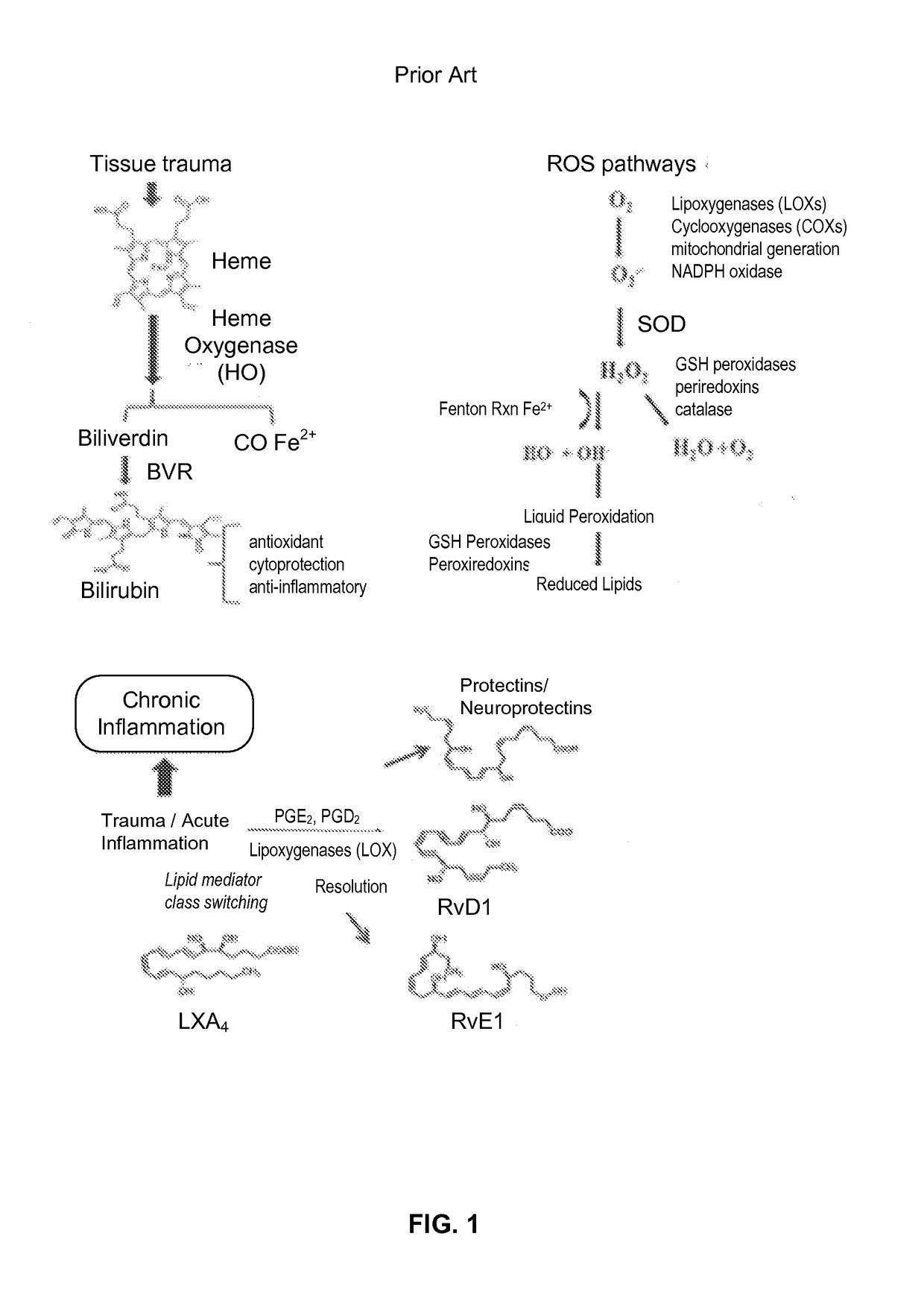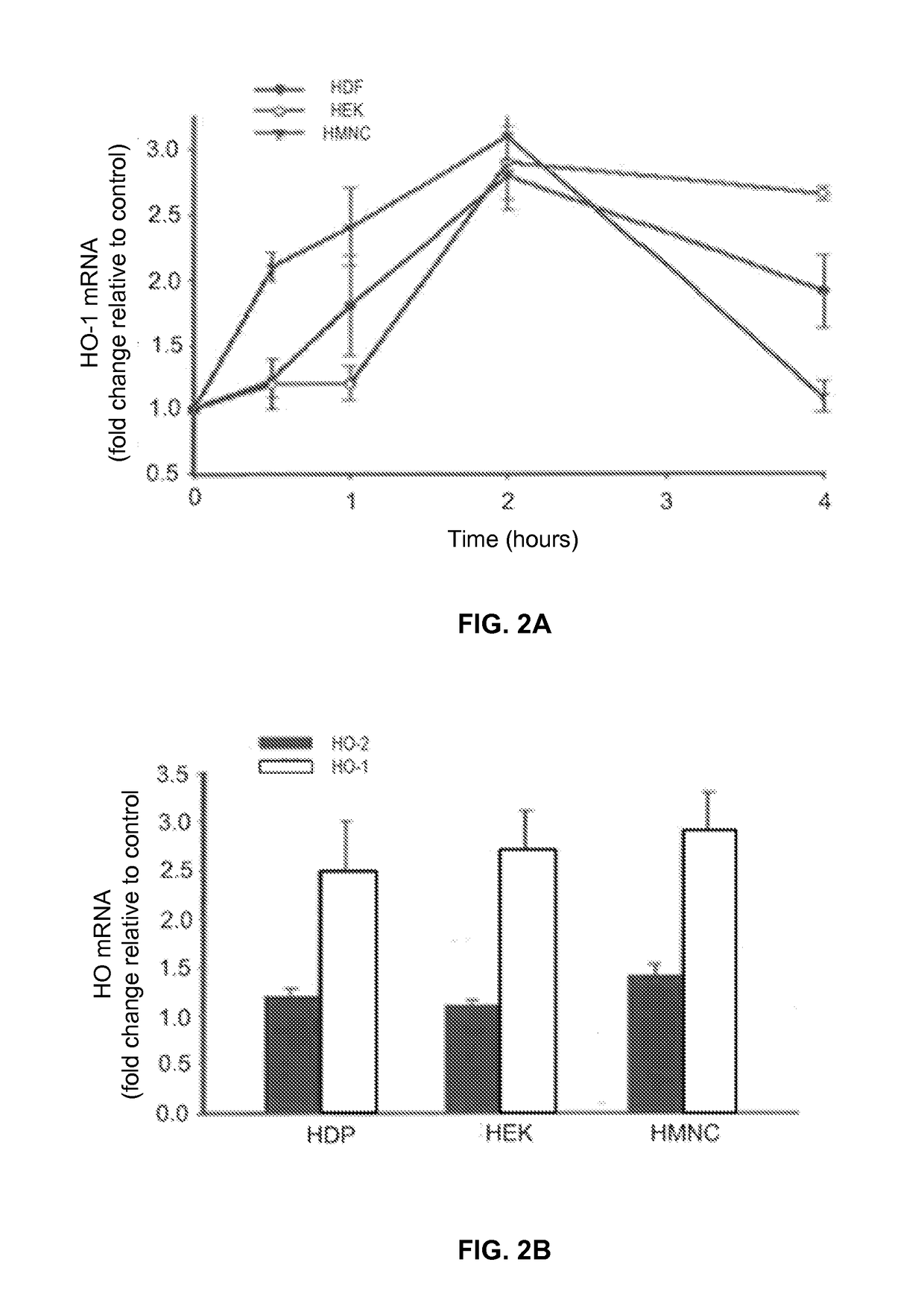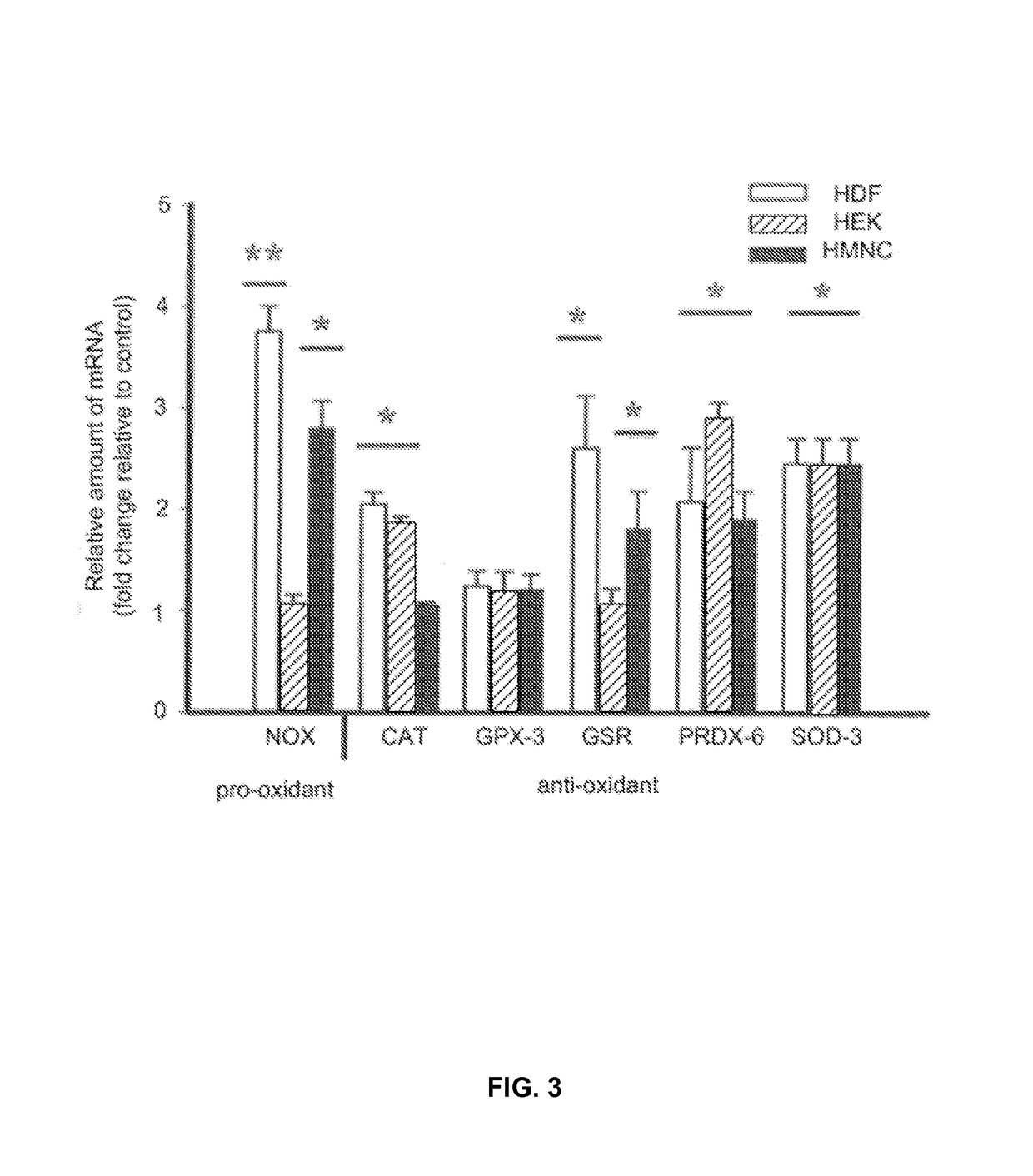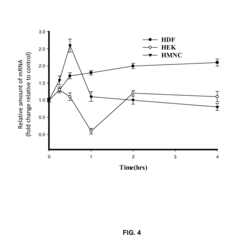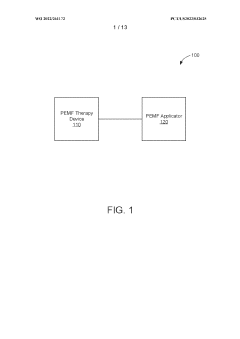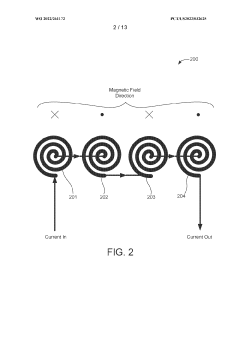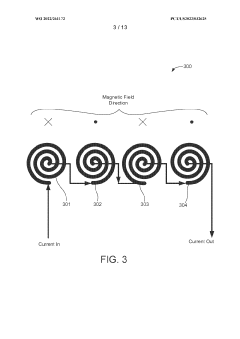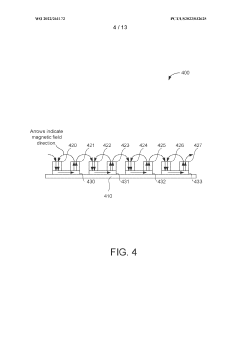How to Engage Patients in Long-Term PEMF Therapy Programs?
AUG 11, 20259 MIN READ
Generate Your Research Report Instantly with AI Agent
Patsnap Eureka helps you evaluate technical feasibility & market potential.
PEMF Therapy Background and Objectives
Pulsed Electromagnetic Field (PEMF) therapy has emerged as a promising non-invasive treatment modality for various health conditions. Originating from the discovery of the piezoelectric effect in bones during the 1950s, PEMF therapy has evolved significantly over the past seven decades. The technology utilizes low-frequency electromagnetic fields to stimulate cellular repair and regeneration, offering potential benefits for pain management, bone healing, and overall wellness.
The primary objective of PEMF therapy is to harness the body's natural healing processes by influencing cellular activity at the molecular level. By generating pulsed electromagnetic fields, PEMF devices aim to enhance cellular energy production, improve circulation, and promote tissue repair. This approach has garnered attention in both medical and wellness communities due to its non-pharmacological nature and minimal side effects.
As the field of PEMF therapy continues to advance, researchers and clinicians are exploring its applications in treating a wide range of conditions, including chronic pain, osteoarthritis, depression, and even neurodegenerative disorders. The technology's versatility and potential for personalized treatment protocols have contributed to its growing popularity in both clinical and home-use settings.
However, despite the promising results observed in various studies, long-term patient engagement remains a significant challenge in PEMF therapy programs. The effectiveness of PEMF treatment often relies on consistent and prolonged use, which can be difficult to maintain for many patients. This challenge has led to increased focus on developing strategies to improve patient adherence and engagement in long-term PEMF therapy regimens.
The current technological landscape of PEMF therapy encompasses a diverse range of devices, from large, stationary units used in clinical settings to portable, wearable devices designed for home use. As the technology evolves, there is a growing trend towards more user-friendly, compact, and interconnected PEMF devices that can seamlessly integrate into patients' daily lives.
Looking ahead, the future of PEMF therapy lies in addressing the engagement challenge while continuing to expand its therapeutic applications. This includes developing more sophisticated treatment protocols, improving device design and usability, and leveraging digital health technologies to enhance patient compliance and monitoring. The ultimate goal is to establish PEMF therapy as a mainstream, evidence-based treatment option that can effectively support long-term health management and improve quality of life for patients across various medical conditions.
The primary objective of PEMF therapy is to harness the body's natural healing processes by influencing cellular activity at the molecular level. By generating pulsed electromagnetic fields, PEMF devices aim to enhance cellular energy production, improve circulation, and promote tissue repair. This approach has garnered attention in both medical and wellness communities due to its non-pharmacological nature and minimal side effects.
As the field of PEMF therapy continues to advance, researchers and clinicians are exploring its applications in treating a wide range of conditions, including chronic pain, osteoarthritis, depression, and even neurodegenerative disorders. The technology's versatility and potential for personalized treatment protocols have contributed to its growing popularity in both clinical and home-use settings.
However, despite the promising results observed in various studies, long-term patient engagement remains a significant challenge in PEMF therapy programs. The effectiveness of PEMF treatment often relies on consistent and prolonged use, which can be difficult to maintain for many patients. This challenge has led to increased focus on developing strategies to improve patient adherence and engagement in long-term PEMF therapy regimens.
The current technological landscape of PEMF therapy encompasses a diverse range of devices, from large, stationary units used in clinical settings to portable, wearable devices designed for home use. As the technology evolves, there is a growing trend towards more user-friendly, compact, and interconnected PEMF devices that can seamlessly integrate into patients' daily lives.
Looking ahead, the future of PEMF therapy lies in addressing the engagement challenge while continuing to expand its therapeutic applications. This includes developing more sophisticated treatment protocols, improving device design and usability, and leveraging digital health technologies to enhance patient compliance and monitoring. The ultimate goal is to establish PEMF therapy as a mainstream, evidence-based treatment option that can effectively support long-term health management and improve quality of life for patients across various medical conditions.
Patient Engagement Market Analysis
The patient engagement market for long-term PEMF (Pulsed Electromagnetic Field) therapy programs is experiencing significant growth, driven by increasing awareness of non-invasive treatment options and the rising prevalence of chronic conditions. This market segment is part of the broader patient engagement solutions market, which is projected to reach substantial value in the coming years.
The demand for patient engagement in PEMF therapy is primarily fueled by the growing incidence of chronic pain, musculoskeletal disorders, and neurological conditions. As patients seek alternatives to traditional pharmacological treatments, PEMF therapy has gained traction due to its non-invasive nature and potential for long-term management of various health issues.
A key trend in this market is the integration of digital health technologies with PEMF devices. This convergence allows for remote monitoring, data collection, and personalized treatment plans, enhancing patient engagement and adherence to long-term therapy programs. Mobile applications and wearable devices connected to PEMF systems are becoming increasingly popular, enabling patients to track their progress and receive real-time feedback.
The market for patient engagement in PEMF therapy is segmented by healthcare settings, including hospitals, clinics, and home care. The home care segment is expected to witness the highest growth rate, as patients prefer the convenience and comfort of receiving treatment in their own environment. This trend is further accelerated by the recent global health crisis, which has emphasized the importance of remote healthcare solutions.
Geographically, North America currently dominates the market, owing to advanced healthcare infrastructure, high adoption rates of new technologies, and a large patient population suffering from chronic conditions. However, the Asia-Pacific region is anticipated to exhibit the fastest growth, driven by increasing healthcare expenditure, rising awareness about alternative therapies, and improving access to medical technologies.
The competitive landscape of the patient engagement market for PEMF therapy is characterized by a mix of established medical device manufacturers and innovative startups. Key players are focusing on developing user-friendly interfaces, improving device portability, and enhancing connectivity features to increase patient engagement and compliance with long-term treatment protocols.
Looking ahead, the market is expected to witness further innovations in personalized treatment algorithms, AI-driven patient engagement strategies, and integration with other complementary therapies. These advancements aim to improve treatment outcomes, reduce healthcare costs, and enhance overall patient satisfaction in long-term PEMF therapy programs.
The demand for patient engagement in PEMF therapy is primarily fueled by the growing incidence of chronic pain, musculoskeletal disorders, and neurological conditions. As patients seek alternatives to traditional pharmacological treatments, PEMF therapy has gained traction due to its non-invasive nature and potential for long-term management of various health issues.
A key trend in this market is the integration of digital health technologies with PEMF devices. This convergence allows for remote monitoring, data collection, and personalized treatment plans, enhancing patient engagement and adherence to long-term therapy programs. Mobile applications and wearable devices connected to PEMF systems are becoming increasingly popular, enabling patients to track their progress and receive real-time feedback.
The market for patient engagement in PEMF therapy is segmented by healthcare settings, including hospitals, clinics, and home care. The home care segment is expected to witness the highest growth rate, as patients prefer the convenience and comfort of receiving treatment in their own environment. This trend is further accelerated by the recent global health crisis, which has emphasized the importance of remote healthcare solutions.
Geographically, North America currently dominates the market, owing to advanced healthcare infrastructure, high adoption rates of new technologies, and a large patient population suffering from chronic conditions. However, the Asia-Pacific region is anticipated to exhibit the fastest growth, driven by increasing healthcare expenditure, rising awareness about alternative therapies, and improving access to medical technologies.
The competitive landscape of the patient engagement market for PEMF therapy is characterized by a mix of established medical device manufacturers and innovative startups. Key players are focusing on developing user-friendly interfaces, improving device portability, and enhancing connectivity features to increase patient engagement and compliance with long-term treatment protocols.
Looking ahead, the market is expected to witness further innovations in personalized treatment algorithms, AI-driven patient engagement strategies, and integration with other complementary therapies. These advancements aim to improve treatment outcomes, reduce healthcare costs, and enhance overall patient satisfaction in long-term PEMF therapy programs.
PEMF Therapy Challenges and Limitations
Despite the potential benefits of Pulsed Electromagnetic Field (PEMF) therapy, several challenges and limitations hinder its widespread adoption and long-term patient engagement. One of the primary obstacles is the lack of standardization in PEMF devices and treatment protocols. This variability makes it difficult for healthcare providers to prescribe consistent and effective treatments, potentially leading to suboptimal outcomes and patient skepticism.
Another significant challenge is the time commitment required for PEMF therapy. Many treatment regimens necessitate daily sessions lasting 30 minutes to several hours, which can be burdensome for patients with busy lifestyles. This time investment often leads to poor adherence, especially when immediate results are not apparent, undermining the therapy's long-term effectiveness.
The cost of PEMF devices and treatments presents another barrier to patient engagement. High-quality PEMF systems can be expensive, and insurance coverage for this therapy is often limited or non-existent. This financial burden may discourage patients from initiating or continuing treatment, particularly for chronic conditions requiring extended use.
Patient education and awareness also pose significant challenges. Many individuals are unfamiliar with PEMF therapy and its potential benefits, leading to skepticism or reluctance to try this treatment modality. The complex scientific principles underlying PEMF can be difficult to communicate effectively, further complicating patient understanding and acceptance.
Additionally, the lack of large-scale, long-term clinical studies on PEMF therapy for various conditions limits its credibility within the medical community. This paucity of robust evidence makes it challenging for healthcare providers to confidently recommend PEMF as a primary or adjunct treatment option, potentially reducing patient trust and engagement.
Technological limitations of current PEMF devices also impact patient engagement. Many systems are bulky, non-portable, or have complex user interfaces, making them inconvenient for home use or travel. The inability to easily integrate PEMF therapy into daily routines can significantly decrease patient compliance and long-term adherence.
Lastly, the potential for side effects, although generally mild, can deter some patients from committing to long-term PEMF therapy. Common side effects such as temporary discomfort, fatigue, or sleep disturbances may lead to treatment discontinuation if not properly managed or explained to patients in advance.
Addressing these challenges and limitations is crucial for improving patient engagement in long-term PEMF therapy programs. Strategies such as developing more user-friendly devices, conducting comprehensive clinical research, improving patient education, and exploring innovative treatment protocols could help overcome these obstacles and enhance the overall effectiveness and adoption of PEMF therapy.
Another significant challenge is the time commitment required for PEMF therapy. Many treatment regimens necessitate daily sessions lasting 30 minutes to several hours, which can be burdensome for patients with busy lifestyles. This time investment often leads to poor adherence, especially when immediate results are not apparent, undermining the therapy's long-term effectiveness.
The cost of PEMF devices and treatments presents another barrier to patient engagement. High-quality PEMF systems can be expensive, and insurance coverage for this therapy is often limited or non-existent. This financial burden may discourage patients from initiating or continuing treatment, particularly for chronic conditions requiring extended use.
Patient education and awareness also pose significant challenges. Many individuals are unfamiliar with PEMF therapy and its potential benefits, leading to skepticism or reluctance to try this treatment modality. The complex scientific principles underlying PEMF can be difficult to communicate effectively, further complicating patient understanding and acceptance.
Additionally, the lack of large-scale, long-term clinical studies on PEMF therapy for various conditions limits its credibility within the medical community. This paucity of robust evidence makes it challenging for healthcare providers to confidently recommend PEMF as a primary or adjunct treatment option, potentially reducing patient trust and engagement.
Technological limitations of current PEMF devices also impact patient engagement. Many systems are bulky, non-portable, or have complex user interfaces, making them inconvenient for home use or travel. The inability to easily integrate PEMF therapy into daily routines can significantly decrease patient compliance and long-term adherence.
Lastly, the potential for side effects, although generally mild, can deter some patients from committing to long-term PEMF therapy. Common side effects such as temporary discomfort, fatigue, or sleep disturbances may lead to treatment discontinuation if not properly managed or explained to patients in advance.
Addressing these challenges and limitations is crucial for improving patient engagement in long-term PEMF therapy programs. Strategies such as developing more user-friendly devices, conducting comprehensive clinical research, improving patient education, and exploring innovative treatment protocols could help overcome these obstacles and enhance the overall effectiveness and adoption of PEMF therapy.
Current Patient Engagement Strategies in PEMF Therapy
01 PEMF therapy devices with patient engagement features
PEMF therapy devices are designed with features to enhance patient engagement. These may include user-friendly interfaces, customizable treatment programs, and interactive elements that allow patients to actively participate in their therapy. Such features can improve treatment adherence and outcomes by making the therapy process more accessible and engaging for patients.- Personalized PEMF therapy programs: PEMF therapy programs can be customized for individual patients based on their specific conditions and needs. These personalized programs enhance patient engagement by tailoring the treatment to each patient's unique requirements, potentially improving outcomes and adherence to the therapy.
- Mobile applications for patient monitoring and engagement: Mobile applications can be used to monitor patient progress, provide reminders for therapy sessions, and allow patients to track their symptoms and improvements. These apps enhance patient engagement by providing a convenient way for patients to interact with their PEMF therapy program and communicate with healthcare providers.
- Integration of PEMF therapy with telemedicine: PEMF therapy programs can be integrated with telemedicine platforms, allowing for remote monitoring and adjustment of treatment parameters. This integration improves patient engagement by providing convenient access to healthcare professionals and enabling real-time adjustments to the therapy based on patient feedback.
- Gamification of PEMF therapy: Incorporating gamification elements into PEMF therapy programs can increase patient engagement and adherence. This approach may include setting goals, tracking progress, and offering rewards or incentives for consistent use of the therapy, making the treatment process more interactive and enjoyable for patients.
- Educational components in PEMF therapy programs: Including educational components within PEMF therapy programs can improve patient understanding of the treatment and its benefits. This may involve providing information about the therapy, expected outcomes, and lifestyle recommendations. Enhanced patient knowledge can lead to increased engagement and commitment to the treatment plan.
02 Mobile applications for PEMF therapy management
Mobile applications are developed to support PEMF therapy programs and enhance patient engagement. These apps can provide treatment reminders, allow patients to track their progress, and offer educational resources about PEMF therapy. They may also facilitate communication between patients and healthcare providers, enabling remote monitoring and adjustment of treatment plans.Expand Specific Solutions03 Telemedicine integration in PEMF therapy
PEMF therapy programs are incorporating telemedicine capabilities to improve patient engagement and care delivery. This integration allows for remote consultations, real-time monitoring of therapy sessions, and adjustment of treatment parameters from a distance. It enhances accessibility to PEMF therapy and enables continuous patient support, particularly beneficial for those in remote areas or with mobility limitations.Expand Specific Solutions04 Personalized PEMF therapy protocols
PEMF therapy programs are developing personalized treatment protocols to enhance patient engagement. These protocols are tailored based on individual patient data, including medical history, treatment response, and real-time biofeedback. By customizing the therapy to each patient's specific needs and preferences, these programs aim to improve treatment efficacy and patient compliance.Expand Specific Solutions05 Gamification of PEMF therapy sessions
PEMF therapy programs are incorporating gamification elements to increase patient engagement and adherence. This approach involves adding game-like features to therapy sessions, such as progress tracking, achievement rewards, and interactive challenges. By making the therapy experience more enjoyable and motivating, gamification can encourage patients to consistently participate in their treatment regimens.Expand Specific Solutions
Key PEMF Device Manufacturers and Providers
The field of long-term PEMF therapy is in a growth phase, with increasing market size and technological advancements. The global PEMF therapy market is expanding due to rising awareness of non-invasive treatments and growing applications in pain management and rehabilitation. Companies like Regenesis Biomedical and Venus Concept are at the forefront, developing innovative devices and systems. Established medical technology firms such as Medtronic and Koninklijke Philips are also entering this space, indicating the technology's growing maturity and market potential. Research institutions like Tsinghua University and Johns Hopkins University are contributing to the scientific understanding of PEMF therapy, further driving its development and adoption in clinical settings.
Medtronic AF Luxembourg SARL
Technical Solution: Medtronic has developed an innovative approach to engage patients in long-term PEMF therapy programs through their advanced neuromodulation devices. Their system incorporates personalized treatment protocols, adaptive stimulation algorithms, and remote monitoring capabilities. The therapy utilizes implantable pulse generators that deliver precise electromagnetic pulses to targeted areas, optimizing therapeutic outcomes[1]. Medtronic's solution includes a patient-friendly mobile app that allows users to track their progress, set reminders, and communicate with healthcare providers. The app also provides educational content and motivational tools to enhance patient adherence[3]. Additionally, their PEMF devices feature rechargeable batteries with extended longevity, reducing the need for frequent replacements and improving the overall patient experience[5].
Strengths: Personalized treatment, remote monitoring, and patient engagement tools. Weaknesses: Invasive procedure required for implantable devices, potential for high initial costs.
Regenesis Biomedical, Inc.
Technical Solution: Regenesis Biomedical has developed the Provant Therapy System, a non-invasive PEMF device designed for long-term patient engagement. The system utilizes a proprietary pulsed electromagnetic field technology that delivers targeted therapy to promote healing and reduce pain. Provant Therapy incorporates a user-friendly interface with pre-programmed treatment protocols, making it easy for patients to adhere to their prescribed regimen[2]. The device is portable and can be used at home, allowing for consistent treatment without frequent clinic visits. Regenesis has also implemented a comprehensive patient support program, including regular follow-ups, educational materials, and a dedicated helpline to address patient concerns and maintain engagement[4]. The system's built-in compliance tracking feature enables healthcare providers to monitor patient adherence and adjust treatment plans as needed[6].
Strengths: Non-invasive, portable, and easy to use at home. Comprehensive patient support program. Weaknesses: May require more active patient participation compared to implantable devices.
Innovative PEMF Engagement Technologies
Treatment of conditions susceptible to pulsed electromagnetic field therapy
PatentActiveUS20170354830A1
Innovation
- PEMF therapy is administered to modulate gene expression associated with inflammation pathways, including heme oxygenase, antioxidant enzymes, lipid mediator biosynthesis, and cytokines, using specific parameters such as electric field strength, pulse rate, and duration to produce measurable clinical effects on pain, nerve function, and wound healing.
Method and apparatus for providing pulsed electromagnetic field therapy
PatentWO2022261172A1
Innovation
- The development of a PEMF therapy applicator with a substrate, ferromagnetic field directors, and multiple PEMF emitter coils configured to direct magnetic fields uniformly, along with additional therapy pads for heating, cooling, or TENS, to enhance treatment efficacy and convenience.
Regulatory Framework for PEMF Therapy Devices
The regulatory framework for PEMF therapy devices plays a crucial role in ensuring patient safety and treatment efficacy. In the United States, the Food and Drug Administration (FDA) oversees the regulation of PEMF devices, classifying them as Class II medical devices. This classification requires manufacturers to submit a 510(k) premarket notification, demonstrating that their device is substantially equivalent to a legally marketed predicate device in terms of safety and effectiveness.
The FDA has established specific guidelines for PEMF devices, including requirements for electromagnetic compatibility, electrical safety, and biocompatibility. Manufacturers must provide clinical data supporting the device's intended use and demonstrate compliance with quality system regulations. Additionally, the FDA mandates appropriate labeling and user instructions to ensure proper use and minimize potential risks.
In the European Union, PEMF devices fall under the Medical Device Regulation (MDR), which came into effect in May 2021. The MDR imposes stricter requirements for clinical evidence, post-market surveillance, and traceability compared to its predecessor, the Medical Device Directive. Manufacturers must obtain CE marking to market their devices in the EU, which involves a conformity assessment process and, in some cases, review by a notified body.
Other countries have their own regulatory frameworks for PEMF devices. For example, Health Canada classifies PEMF devices as Class II medical devices, requiring a Medical Device License for sale in Canada. In Australia, the Therapeutic Goods Administration (TGA) regulates PEMF devices under the Australian Register of Therapeutic Goods (ARTG).
Regulatory compliance extends beyond initial approval, with ongoing requirements for post-market surveillance, adverse event reporting, and quality management systems. Manufacturers must continuously monitor the safety and performance of their devices and implement necessary updates or recalls if issues arise.
As PEMF therapy gains popularity for long-term treatment programs, regulatory bodies are likely to adapt their frameworks to address specific concerns related to extended use. This may include more stringent requirements for long-term safety data, patient monitoring protocols, and guidelines for integrating PEMF therapy into comprehensive treatment plans.
Understanding and navigating this complex regulatory landscape is essential for manufacturers, healthcare providers, and patients engaged in long-term PEMF therapy programs. Compliance with these regulations not only ensures legal market access but also contributes to patient trust and the overall success of PEMF therapy adoption.
The FDA has established specific guidelines for PEMF devices, including requirements for electromagnetic compatibility, electrical safety, and biocompatibility. Manufacturers must provide clinical data supporting the device's intended use and demonstrate compliance with quality system regulations. Additionally, the FDA mandates appropriate labeling and user instructions to ensure proper use and minimize potential risks.
In the European Union, PEMF devices fall under the Medical Device Regulation (MDR), which came into effect in May 2021. The MDR imposes stricter requirements for clinical evidence, post-market surveillance, and traceability compared to its predecessor, the Medical Device Directive. Manufacturers must obtain CE marking to market their devices in the EU, which involves a conformity assessment process and, in some cases, review by a notified body.
Other countries have their own regulatory frameworks for PEMF devices. For example, Health Canada classifies PEMF devices as Class II medical devices, requiring a Medical Device License for sale in Canada. In Australia, the Therapeutic Goods Administration (TGA) regulates PEMF devices under the Australian Register of Therapeutic Goods (ARTG).
Regulatory compliance extends beyond initial approval, with ongoing requirements for post-market surveillance, adverse event reporting, and quality management systems. Manufacturers must continuously monitor the safety and performance of their devices and implement necessary updates or recalls if issues arise.
As PEMF therapy gains popularity for long-term treatment programs, regulatory bodies are likely to adapt their frameworks to address specific concerns related to extended use. This may include more stringent requirements for long-term safety data, patient monitoring protocols, and guidelines for integrating PEMF therapy into comprehensive treatment plans.
Understanding and navigating this complex regulatory landscape is essential for manufacturers, healthcare providers, and patients engaged in long-term PEMF therapy programs. Compliance with these regulations not only ensures legal market access but also contributes to patient trust and the overall success of PEMF therapy adoption.
PEMF Therapy Cost-Benefit Analysis
When evaluating the cost-benefit analysis of PEMF therapy programs, it's crucial to consider both the financial and health-related aspects. The initial investment in PEMF devices can be substantial, ranging from a few hundred to several thousand dollars depending on the quality and features. However, this upfront cost should be weighed against the potential long-term savings in medical expenses and improved quality of life.
For patients with chronic conditions, PEMF therapy may reduce the need for pain medications, physical therapy sessions, and other conventional treatments. This can lead to significant cost savings over time. Additionally, the non-invasive nature of PEMF therapy means fewer risks of complications and side effects, potentially avoiding costly medical interventions.
The benefits of PEMF therapy extend beyond direct medical costs. Improved pain management and enhanced mobility can lead to increased productivity and fewer missed workdays. This indirect economic benefit should be factored into the overall cost-benefit analysis, as it contributes to the patient's financial well-being and quality of life.
It's important to consider the durability and lifespan of PEMF devices. High-quality devices may have a higher initial cost but can provide reliable service for many years, spreading the investment over a longer period. This longevity enhances the cost-effectiveness of the therapy, especially for patients requiring long-term treatment.
Insurance coverage for PEMF therapy varies widely, which can significantly impact the cost-benefit ratio for patients. While some insurance plans may cover PEMF treatments or devices, many consider it an alternative therapy and do not provide coverage. Patients should investigate their insurance options and consider potential out-of-pocket expenses in their analysis.
The time investment required for PEMF therapy should also be evaluated. While many PEMF devices allow for treatment during sleep or daily activities, some may require dedicated therapy sessions. The opportunity cost of this time should be weighed against the potential benefits and improvements in daily functioning.
Lastly, the potential for reduced healthcare utilization should be considered. If PEMF therapy effectively manages chronic conditions, it may lead to fewer doctor visits, hospitalizations, and other medical interventions. This reduction in healthcare utilization not only benefits the patient financially but also contributes to overall healthcare system efficiency.
For patients with chronic conditions, PEMF therapy may reduce the need for pain medications, physical therapy sessions, and other conventional treatments. This can lead to significant cost savings over time. Additionally, the non-invasive nature of PEMF therapy means fewer risks of complications and side effects, potentially avoiding costly medical interventions.
The benefits of PEMF therapy extend beyond direct medical costs. Improved pain management and enhanced mobility can lead to increased productivity and fewer missed workdays. This indirect economic benefit should be factored into the overall cost-benefit analysis, as it contributes to the patient's financial well-being and quality of life.
It's important to consider the durability and lifespan of PEMF devices. High-quality devices may have a higher initial cost but can provide reliable service for many years, spreading the investment over a longer period. This longevity enhances the cost-effectiveness of the therapy, especially for patients requiring long-term treatment.
Insurance coverage for PEMF therapy varies widely, which can significantly impact the cost-benefit ratio for patients. While some insurance plans may cover PEMF treatments or devices, many consider it an alternative therapy and do not provide coverage. Patients should investigate their insurance options and consider potential out-of-pocket expenses in their analysis.
The time investment required for PEMF therapy should also be evaluated. While many PEMF devices allow for treatment during sleep or daily activities, some may require dedicated therapy sessions. The opportunity cost of this time should be weighed against the potential benefits and improvements in daily functioning.
Lastly, the potential for reduced healthcare utilization should be considered. If PEMF therapy effectively manages chronic conditions, it may lead to fewer doctor visits, hospitalizations, and other medical interventions. This reduction in healthcare utilization not only benefits the patient financially but also contributes to overall healthcare system efficiency.
Unlock deeper insights with Patsnap Eureka Quick Research — get a full tech report to explore trends and direct your research. Try now!
Generate Your Research Report Instantly with AI Agent
Supercharge your innovation with Patsnap Eureka AI Agent Platform!
